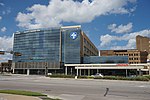Lake Cliff, Dallas
Dallas County, Texas geography stubsDallas LandmarksDallas stubsHistoric districts in the United StatesNational Register of Historic Places in Dallas ... and 2 more
Neighborhoods in Oak Cliff, DallasTexas Registered Historic Place stubs

Lake Cliff is a neighborhood in the northern part of the Oak Cliff area of Dallas, Texas (USA). It surrounds Lake Cliff, a small freshwater lake. From 1906 to 1913, Oak Cliff was home to an amusement park that, according to its founders, outdid Coney Island. Lake Cliff Park featured a 2,500-seat theater, an 18,000-square-foot roller-skating rink, a roller coaster, Japanese village, mechanical swings, and water rides. Dallasites could take a streetcar link straight to its front door and marvel at the park’s electrical lighting. Today, visitors can still spy remnants of the brick-lined channel.
Excerpt from the Wikipedia article Lake Cliff, Dallas (License: CC BY-SA 3.0, Authors, Images).Lake Cliff, Dallas
East Colorado Boulevard, Dallas
Geographical coordinates (GPS) Address Nearby Places Show on map
Geographical coordinates (GPS)
| Latitude | Longitude |
|---|---|
| N 32.756388888889 ° | E -96.818333333333 ° |
Address
Lake Cliff Fountain
East Colorado Boulevard
75203 Dallas
Texas, United States
Open on Google Maps





